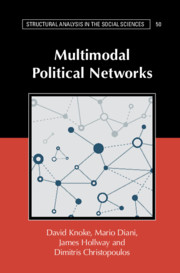45 results
27 - On Movements
- from IV - New Perspectives
-
-
- Book:
- Personal Networks
- Published online:
- 01 October 2021
- Print publication:
- 16 September 2021, pp 696-717
-
- Chapter
- Export citation
2 - Multimodal Graphs and Matrices
-
- Book:
- Multimodal Political Networks
- Published online:
- 12 May 2021
- Print publication:
- 27 May 2021, pp 20-52
-
- Chapter
- Export citation
1 - Politics, Communities, and Power
-
- Book:
- Multimodal Political Networks
- Published online:
- 12 May 2021
- Print publication:
- 27 May 2021, pp 1-19
-
- Chapter
- Export citation
Index
-
- Book:
- Multimodal Political Networks
- Published online:
- 12 May 2021
- Print publication:
- 27 May 2021, pp 261-264
-
- Chapter
- Export citation
References
-
- Book:
- Multimodal Political Networks
- Published online:
- 12 May 2021
- Print publication:
- 27 May 2021, pp 227-260
-
- Chapter
- Export citation
Frontmatter
-
- Book:
- Multimodal Political Networks
- Published online:
- 12 May 2021
- Print publication:
- 27 May 2021, pp i-vi
-
- Chapter
- Export citation
3 - Agency, Influence, Power
-
- Book:
- Multimodal Political Networks
- Published online:
- 12 May 2021
- Print publication:
- 27 May 2021, pp 53-77
-
- Chapter
- Export citation
Contents
-
- Book:
- Multimodal Political Networks
- Published online:
- 12 May 2021
- Print publication:
- 27 May 2021, pp vii-viii
-
- Chapter
- Export citation
Preface
-
- Book:
- Multimodal Political Networks
- Published online:
- 12 May 2021
- Print publication:
- 27 May 2021, pp xv-xx
-
- Chapter
- Export citation
5 - Individuals in Associations
-
- Book:
- Multimodal Political Networks
- Published online:
- 12 May 2021
- Print publication:
- 27 May 2021, pp 93-133
-
- Chapter
- Export citation
Appendices
-
- Book:
- Multimodal Political Networks
- Published online:
- 12 May 2021
- Print publication:
- 27 May 2021, pp 207-226
-
- Chapter
- Export citation
Tables
-
- Book:
- Multimodal Political Networks
- Published online:
- 12 May 2021
- Print publication:
- 27 May 2021, pp xi-xiv
-
- Chapter
- Export citation
4 - Political Communities in a Policy Network
-
- Book:
- Multimodal Political Networks
- Published online:
- 12 May 2021
- Print publication:
- 27 May 2021, pp 78-92
-
- Chapter
- Export citation
8 - Legislative Influence
-
- Book:
- Multimodal Political Networks
- Published online:
- 12 May 2021
- Print publication:
- 27 May 2021, pp 180-196
-
- Chapter
- Export citation
7 - Nations Trading and Fighting
-
- Book:
- Multimodal Political Networks
- Published online:
- 12 May 2021
- Print publication:
- 27 May 2021, pp 158-179
-
- Chapter
- Export citation
Figures
-
- Book:
- Multimodal Political Networks
- Published online:
- 12 May 2021
- Print publication:
- 27 May 2021, pp ix-x
-
- Chapter
- Export citation
9 - The Potential of Multimodal Political Networks
-
- Book:
- Multimodal Political Networks
- Published online:
- 12 May 2021
- Print publication:
- 27 May 2021, pp 197-206
-
- Chapter
- Export citation
6 - Agents and Events in Collective Action Fields
-
- Book:
- Multimodal Political Networks
- Published online:
- 12 May 2021
- Print publication:
- 27 May 2021, pp 134-157
-
- Chapter
- Export citation

Multimodal Political Networks
-
- Published online:
- 12 May 2021
- Print publication:
- 27 May 2021
Copyright page
-
- Book:
- The Cement of Civil Society
- Published online:
- 05 May 2015
- Print publication:
- 21 May 2015, pp vi-vi
-
- Chapter
- Export citation

